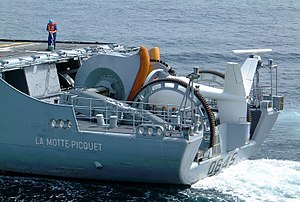
Back Sonar Afrikaans سونار Arabic Sonar AST Sonar Azerbaijani سونار AZB Сонар Bulgarian Sonar Catalan ᎤᏃᏴᏨ ᎠᏣᏘᏍᎩ CHR سۆنار CKB Sonar Czech


Sonar (sound navigation and ranging or sonic navigation and ranging)[2] is a technique that uses sound propagation (usually underwater, as in submarine navigation) to navigate, measure distances (ranging), communicate with or detect objects on or under the surface of the water, such as other vessels.[3]
"Sonar" can refer to one of two types of technology: passive sonar means listening for the sound made by vessels; active sonar means emitting pulses of sounds and listening for echoes. Sonar may be used as a means of acoustic location and of measurement of the echo characteristics of "targets" in the water.[4] Acoustic location in air was used before the introduction of radar. Sonar may also be used for robot navigation,[5] and sodar (an upward-looking in-air sonar) is used for atmospheric investigations. The term sonar is also used for the equipment used to generate and receive the sound. The acoustic frequencies used in sonar systems vary from very low (infrasonic) to extremely high (ultrasonic). The study of underwater sound is known as underwater acoustics or hydroacoustics.
The first recorded use of the technique was in 1490 by Leonardo da Vinci, who used a tube inserted into the water to detect vessels by ear.[6] It was developed during World War I to counter the growing threat of submarine warfare, with an operational passive sonar system in use by 1918.[3] Modern active sonar systems use an acoustic transducer to generate a sound wave which is reflected from target objects.[3]
- ^ Jürgen Rohwer; Mikhail Monakov; Mikhail S. Monakov (2001). Stalin's Ocean-going Fleet: Soviet Naval Strategy and Shipbuilding Programmes, 1935–1953. Psychology Press. p. 264. ISBN 9780714648958.
- ^ Administrative Practices Glossary of Standardized Terms. Air Force AFM. U.S. Government Printing Office. 1961. p. 129. Retrieved 2022-11-02.
- ^ a b c "Sonar". Encyclopaedia Britannica. Retrieved 18 January 2019.
- ^ Wragg, David W. (1973). A Dictionary of Aviation (first ed.). Osprey. p. 245. ISBN 9780850451634.
- ^ David Ribas; Pere Ridao; José Neira (26 July 2010). Underwater SLAM for Structured Environments Using an Imaging Sonar. Springer Science & Business Media. ISBN 978-3-642-14039-6.
- ^ Cite error: The named reference
DaVinciwas invoked but never defined (see the help page).